The costume of the Late middle Ages By

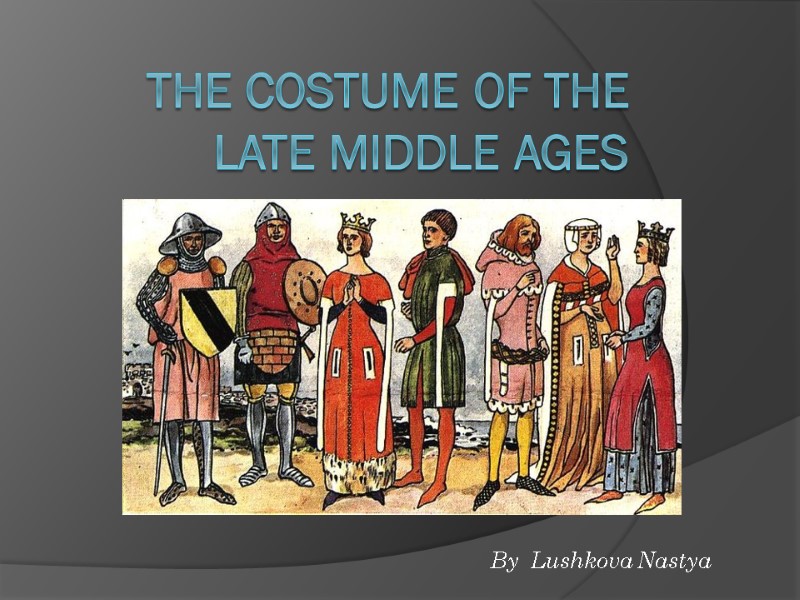
The costume of the Late middle Ages By Lushkova Nastya
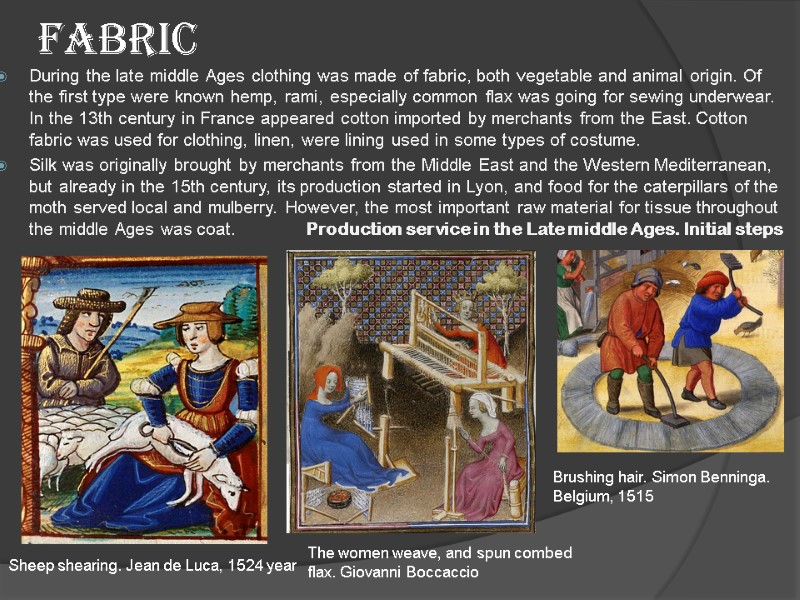
Fabric During the late middle Ages clothing was made of fabric, both vegetable and animal origin. Of the first type were known hemp, rami, especially common flax was going for sewing underwear. In the 13th century in France appeared cotton imported by merchants from the East. Cotton fabric was used for clothing, linen, were lining used in some types of costume. Silk was originally brought by merchants from the Middle East and the Western Mediterranean, but already in the 15th century, its production started in Lyon, and food for the caterpillars of the moth served local and mulberry. However, the most important raw material for tissue throughout the middle Ages was coat. Production service in the Late middle Ages. Initial steps Sheep shearing. Jean de Luca, 1524 year The women weave, and spun combed flax. Giovanni Boccaccio Brushing hair. Simon Benninga. Belgium, 1515
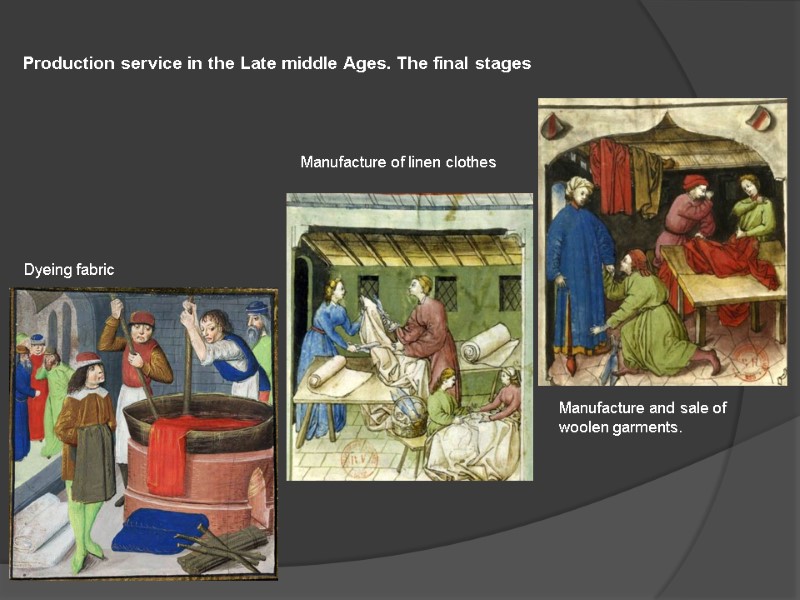
Production service in the Late middle Ages. The final stages Dyeing fabric Manufacture of linen clothes Manufacture and sale of woolen garments.
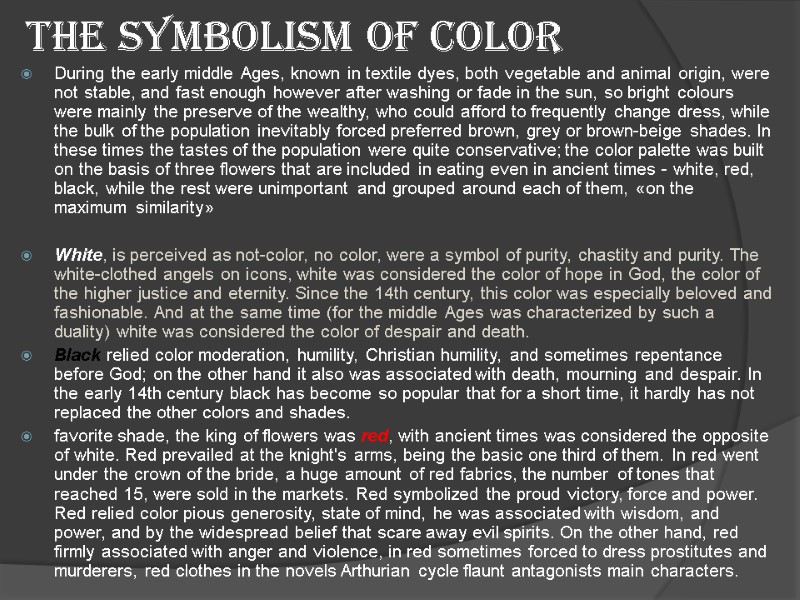
The symbolism of color During the early middle Ages, known in textile dyes, both vegetable and animal origin, were not stable, and fast enough however after washing or fade in the sun, so bright colours were mainly the preserve of the wealthy, who could afford to frequently change dress, while the bulk of the population inevitably forced preferred brown, grey or brown-beige shades. In these times the tastes of the population were quite conservative; the color palette was built on the basis of three flowers that are included in eating even in ancient times - white, red, black, while the rest were unimportant and grouped around each of them, «on the maximum similarity» White, is perceived as not-color, no color, were a symbol of purity, chastity and purity. The white-clothed angels on icons, white was considered the color of hope in God, the color of the higher justice and eternity. Since the 14th century, this color was especially beloved and fashionable. And at the same time (for the middle Ages was characterized by such a duality) white was considered the color of despair and death. Black relied color moderation, humility, Christian humility, and sometimes repentance before God; on the other hand it also was associated with death, mourning and despair. In the early 14th century black has become so popular that for a short time, it hardly has not replaced the other colors and shades. favorite shade, the king of flowers was red, with ancient times was considered the opposite of white. Red prevailed at the knight's arms, being the basic one third of them. In red went under the crown of the bride, a huge amount of red fabrics, the number of tones that reached 15, were sold in the markets. Red symbolized the proud victory, force and power. Red relied color pious generosity, state of mind, he was associated with wisdom, and power, and by the widespread belief that scare away evil spirits. On the other hand, red firmly associated with anger and violence, in red sometimes forced to dress prostitutes and murderers, red clothes in the novels Arthurian cycle flaunt antagonists main characters.
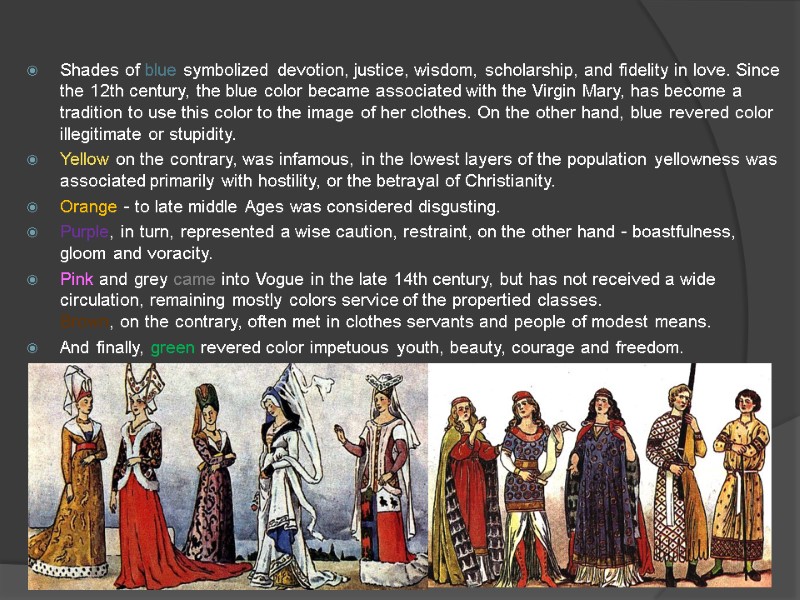
Shades of blue symbolized devotion, justice, wisdom, scholarship, and fidelity in love. Since the 12th century, the blue color became associated with the Virgin Mary, has become a tradition to use this color to the image of her clothes. On the other hand, blue revered color illegitimate or stupidity. Yellow on the contrary, was infamous, in the lowest layers of the population yellowness was associated primarily with hostility, or the betrayal of Christianity. Orange - to late middle Ages was considered disgusting. Purple, in turn, represented a wise caution, restraint, on the other hand - boastfulness, gloom and voracity. Pink and grey came into Vogue in the late 14th century, but has not received a wide circulation, remaining mostly colors service of the propertied classes. Brown, on the contrary, often met in clothes servants and people of modest means. And finally, green revered color impetuous youth, beauty, courage and freedom.
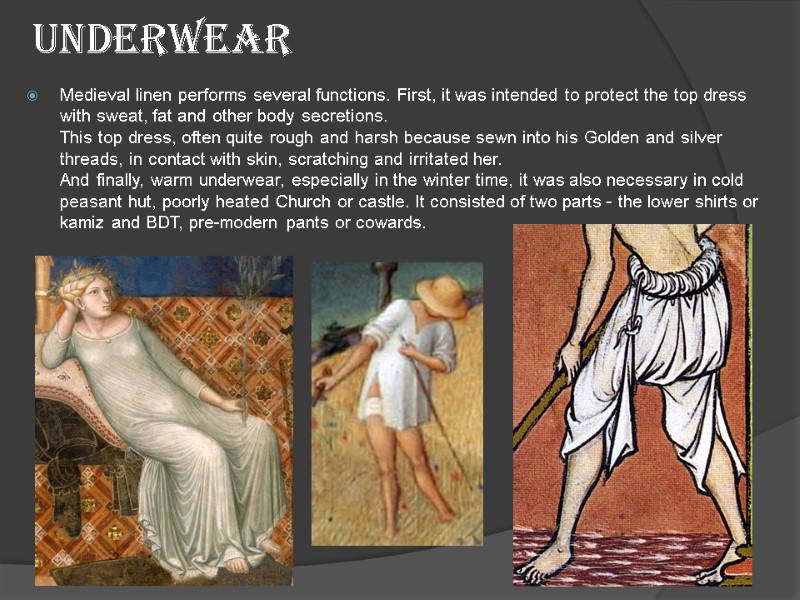
underwear Medieval linen performs several functions. First, it was intended to protect the top dress with sweat, fat and other body secretions. This top dress, often quite rough and harsh because sewn into his Golden and silver threads, in contact with skin, scratching and irritated her. And finally, warm underwear, especially in the winter time, it was also necessary in cold peasant hut, poorly heated Church or castle. It consisted of two parts - the lower shirts or kamiz and BDT, pre-modern pants or cowards.
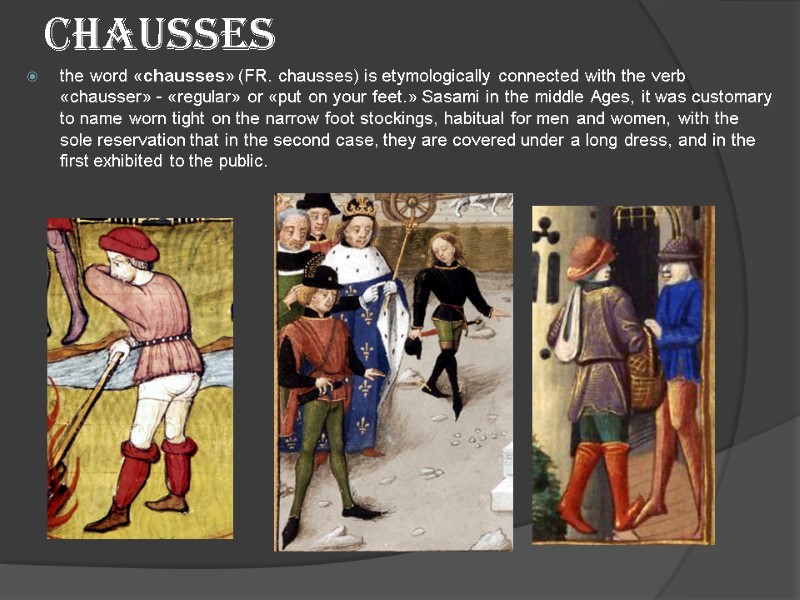
chausses the word «chausses» (FR. chausses) is etymologically connected with the verb «chausser» - «regular» or «put on your feet.» Sasami in the middle Ages, it was customary to name worn tight on the narrow foot stockings, habitual for men and women, with the sole reservation that in the second case, they are covered under a long dress, and in the first exhibited to the public.
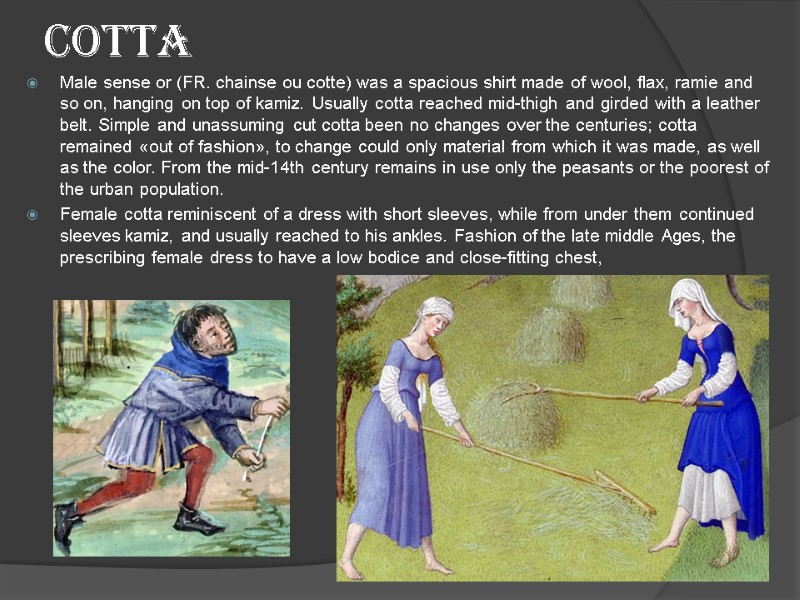
cotta Male sense or (FR. chainse ou cotte) was a spacious shirt made of wool, flax, ramie and so on, hanging on top of kamiz. Usually cotta reached mid-thigh and girded with a leather belt. Simple and unassuming cut cotta been no changes over the centuries; cotta remained «out of fashion», to change could only material from which it was made, as well as the color. From the mid-14th century remains in use only the peasants or the poorest of the urban population. Female cotta reminiscent of a dress with short sleeves, while from under them continued sleeves kamiz, and usually reached to his ankles. Fashion of the late middle Ages, the prescribing female dress to have a low bodice and close-fitting chest,
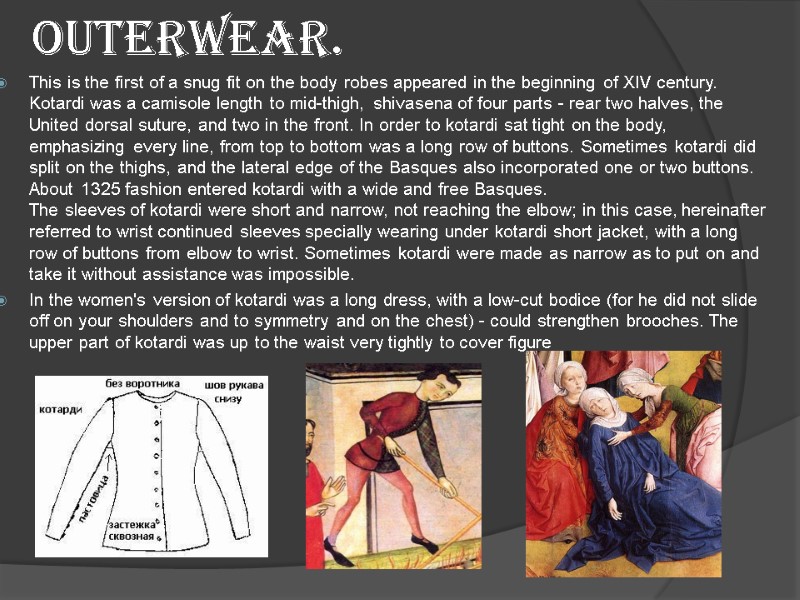
Outerwear. This is the first of a snug fit on the body robes appeared in the beginning of XIV century. Kotardi was a camisole length to mid-thigh, shivasena of four parts - rear two halves, the United dorsal suture, and two in the front. In order to kotardi sat tight on the body, emphasizing every line, from top to bottom was a long row of buttons. Sometimes kotardi did split on the thighs, and the lateral edge of the Basques also incorporated one or two buttons. About 1325 fashion entered kotardi with a wide and free Basques. The sleeves of kotardi were short and narrow, not reaching the elbow; in this case, hereinafter referred to wrist continued sleeves specially wearing under kotardi short jacket, with a long row of buttons from elbow to wrist. Sometimes kotardi were made as narrow as to put on and take it without assistance was impossible. In the women's version of kotardi was a long dress, with a low-cut bodice (for he did not slide off on your shoulders and to symmetry and on the chest) - could strengthen brooches. The upper part of kotardi was up to the waist very tightly to cover figure
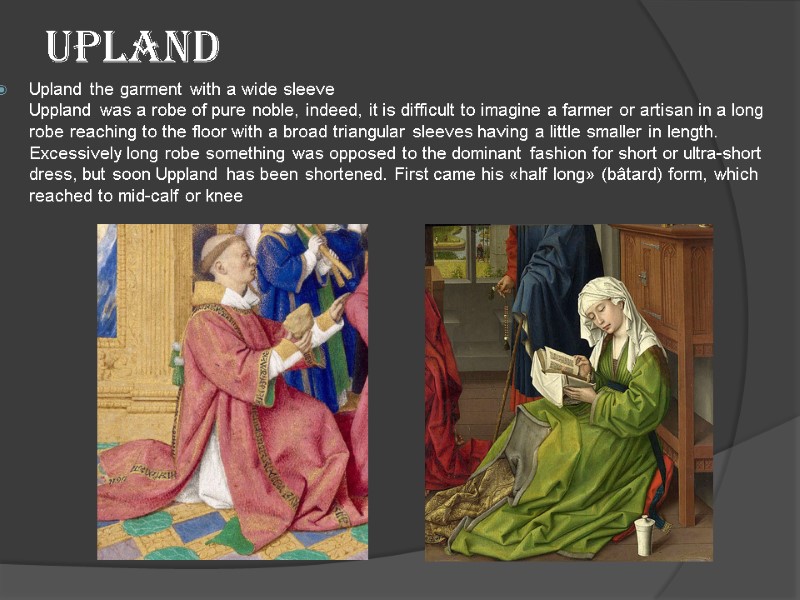
Upland Upland the garment with a wide sleeve Uppland was a robe of pure noble, indeed, it is difficult to imagine a farmer or artisan in a long robe reaching to the floor with a broad triangular sleeves having a little smaller in length. Excessively long robe something was opposed to the dominant fashion for short or ultra-short dress, but soon Uppland has been shortened. First came his «half long» (bâtard) form, which reached to mid-calf or knee
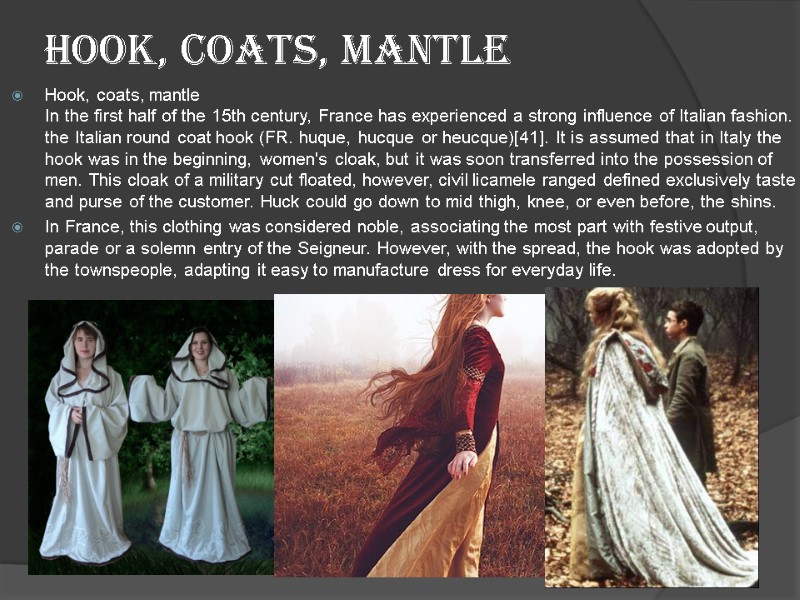
Hook, coats, mantle Hook, coats, mantle In the first half of the 15th century, France has experienced a strong influence of Italian fashion. the Italian round coat hook (FR. huque, hucque or heuсque)[41]. It is assumed that in Italy the hook was in the beginning, women's cloak, but it was soon transferred into the possession of men. This cloak of a military cut floated, however, civil licamele ranged defined exclusively taste and purse of the customer. Huck could go down to mid thigh, knee, or even before, the shins. In France, this clothing was considered noble, associating the most part with festive output, parade or a solemn entry of the Seigneur. However, with the spread, the hook was adopted by the townspeople, adapting it easy to manufacture dress for everyday life.
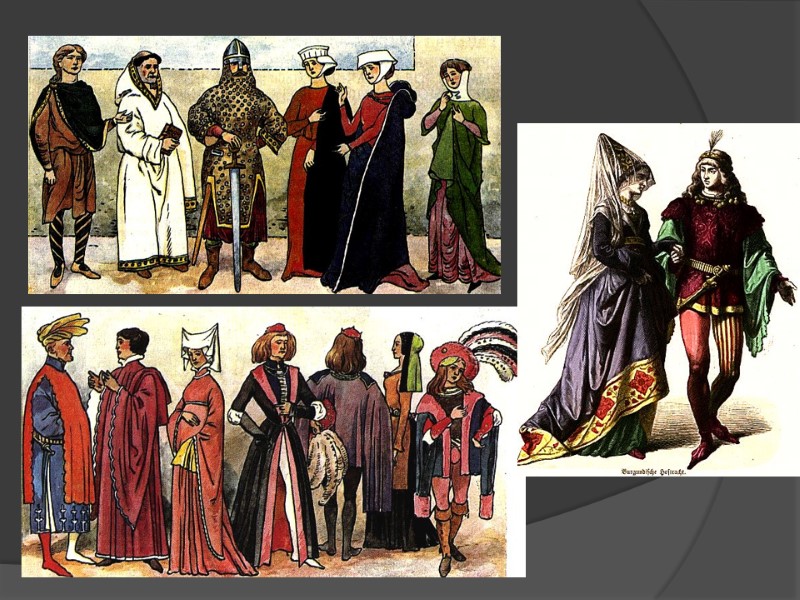
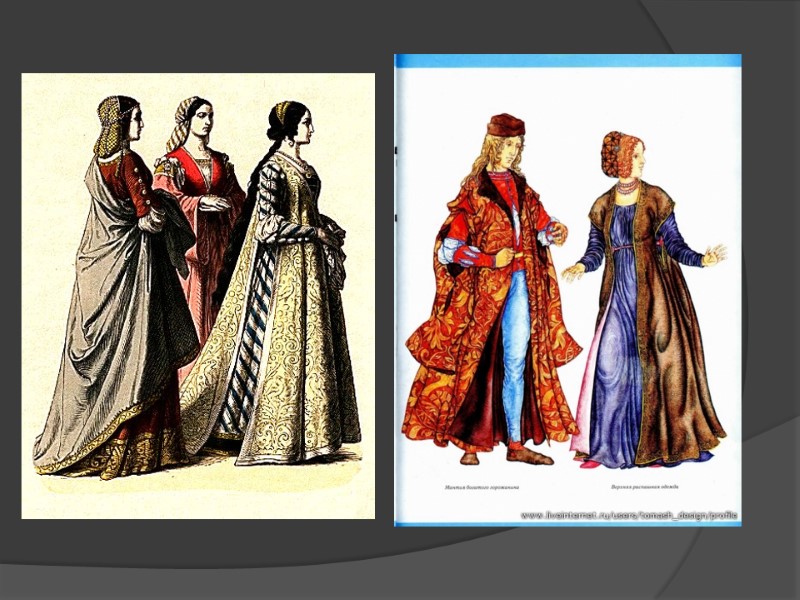
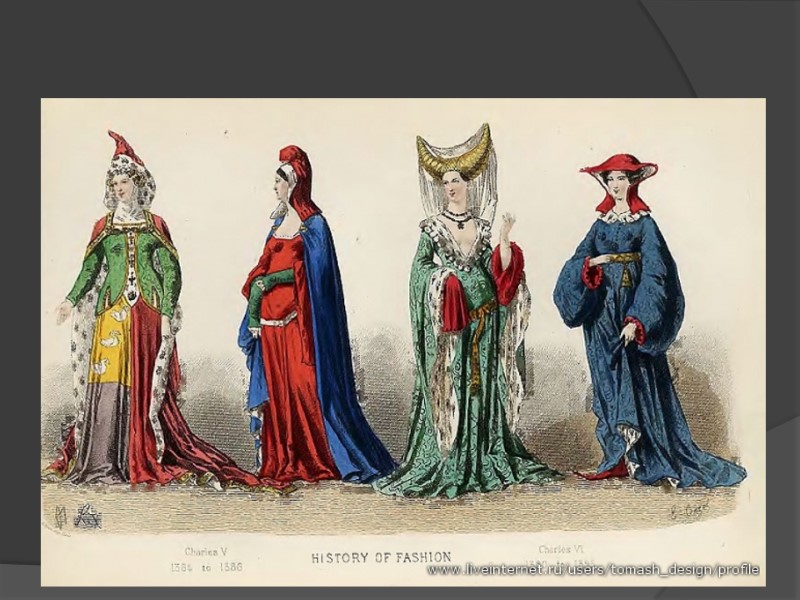
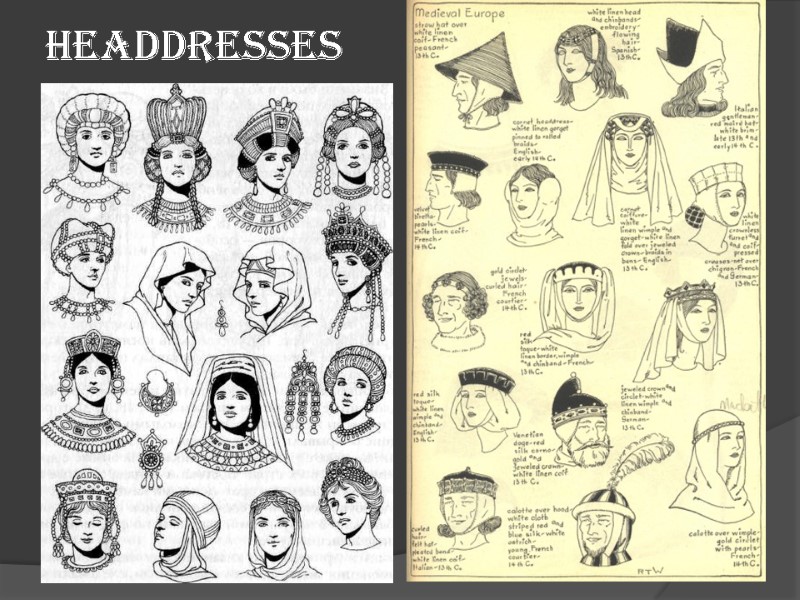
Headdresses
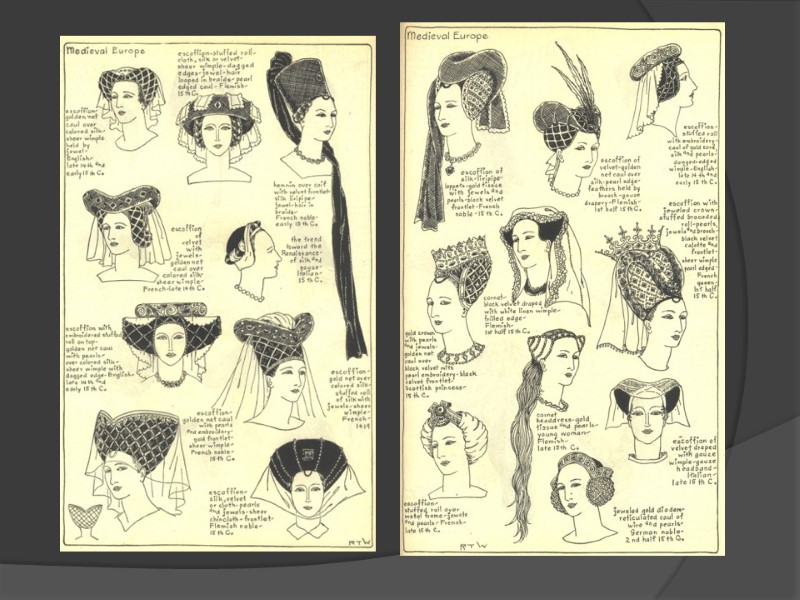
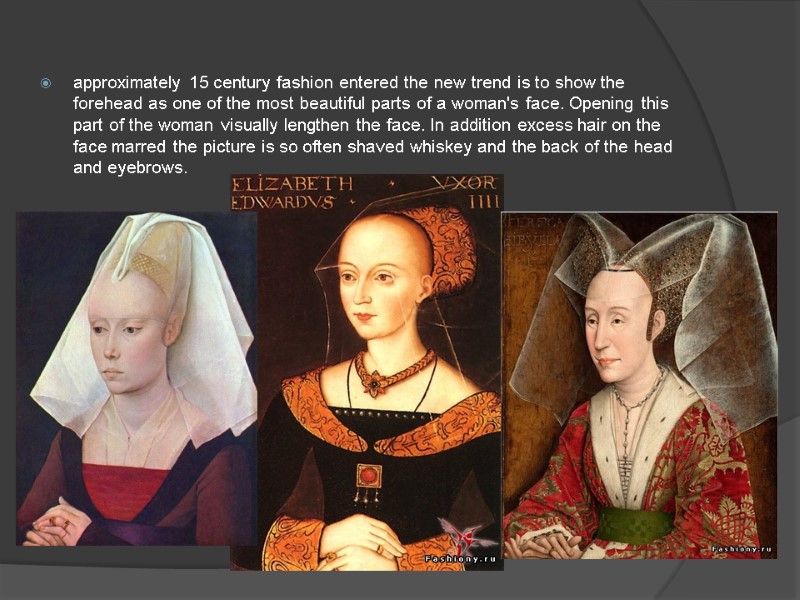
approximately 15 century fashion entered the new trend is to show the forehead as one of the most beautiful parts of a woman's face. Opening this part of the woman visually lengthen the face. In addition excess hair on the face marred the picture is so often shaved whiskey and the back of the head and eyebrows.
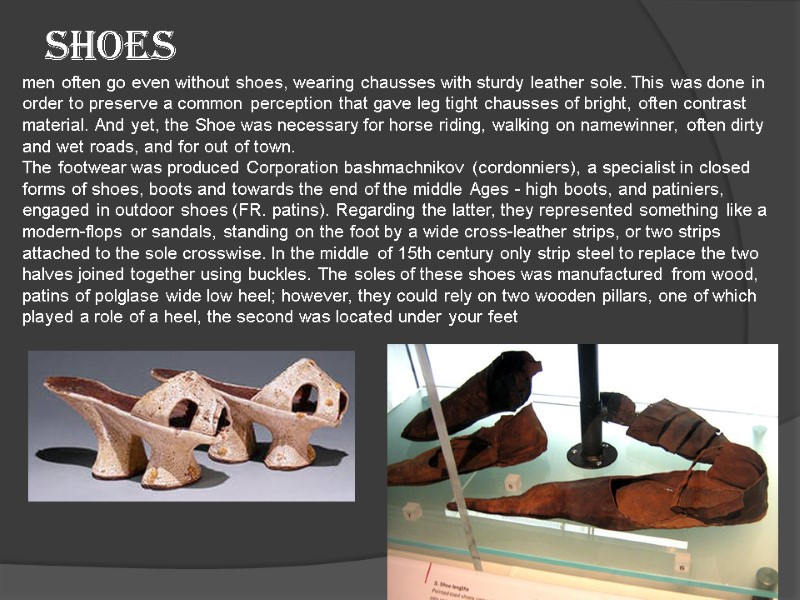
shoes men often go even without shoes, wearing chausses with sturdy leather sole. This was done in order to preserve a common perception that gave leg tight chausses of bright, often contrast material. And yet, the Shoe was necessary for horse riding, walking on namewinner, often dirty and wet roads, and for out of town. The footwear was produced Corporation bashmachnikov (cordonniers), a specialist in closed forms of shoes, boots and towards the end of the middle Ages - high boots, and patiniers, engaged in outdoor shoes (FR. patins). Regarding the latter, they represented something like a modern-flops or sandals, standing on the foot by a wide cross-leather strips, or two strips attached to the sole crosswise. In the middle of 15th century only strip steel to replace the two halves joined together using buckles. The soles of these shoes was manufactured from wood, patins of polglase wide low heel; however, they could rely on two wooden pillars, one of which played a role of a heel, the second was located under your feet
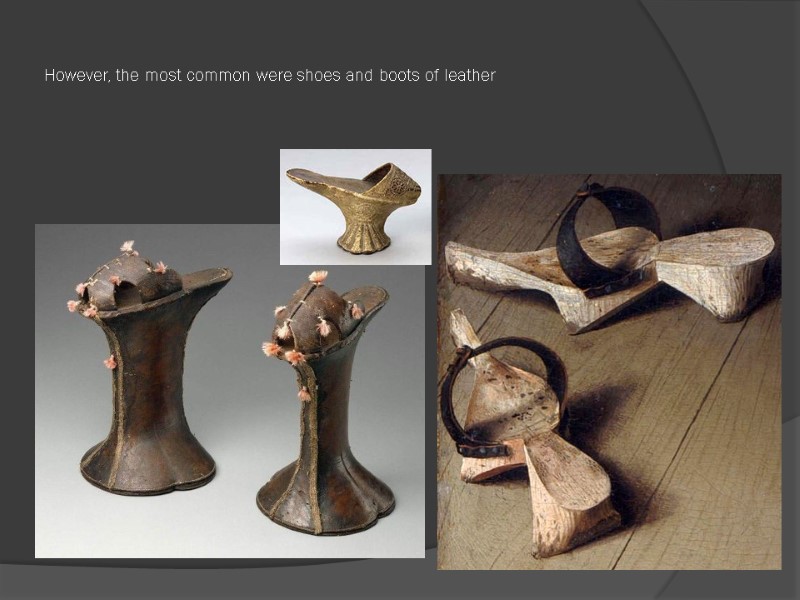
However, the most common were shoes and boots of leather
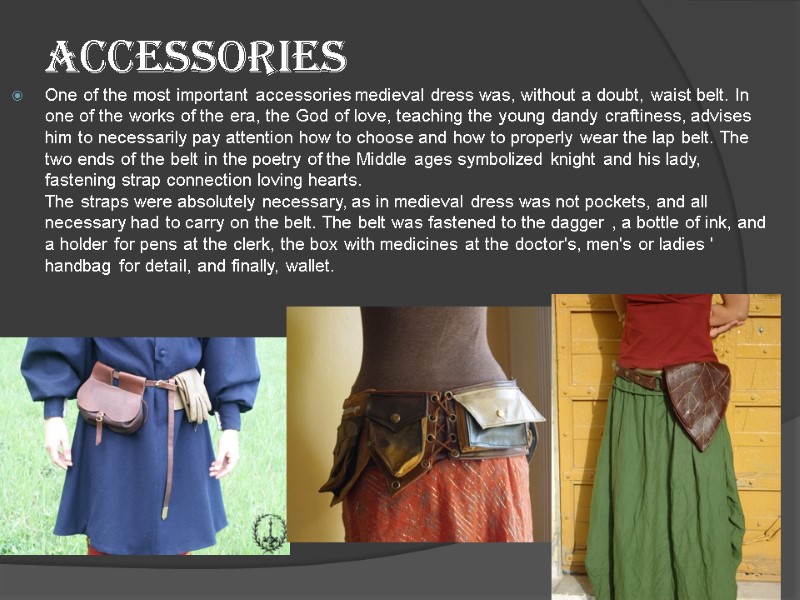
accessories One of the most important accessories medieval dress was, without a doubt, waist belt. In one of the works of the era, the God of love, teaching the young dandy craftiness, advises him to necessarily pay attention how to choose and how to properly wear the lap belt. The two ends of the belt in the poetry of the Middle ages symbolized knight and his lady, fastening strap connection loving hearts. The straps were absolutely necessary, as in medieval dress was not pockets, and all necessary had to carry on the belt. The belt was fastened to the dagger , a bottle of ink, and a holder for pens at the clerk, the box with medicines at the doctor's, men's or ladies ' handbag for detail, and finally, wallet.
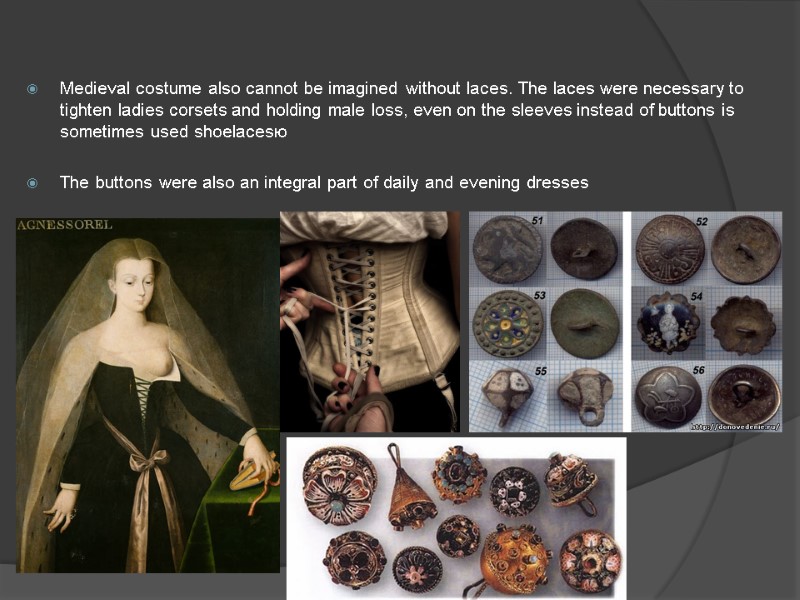
Medieval costume also cannot be imagined without laces. The laces were necessary to tighten ladies corsets and holding male loss, even on the sleeves instead of buttons is sometimes used shoelacesю The buttons were also an integral part of daily and evening dresses
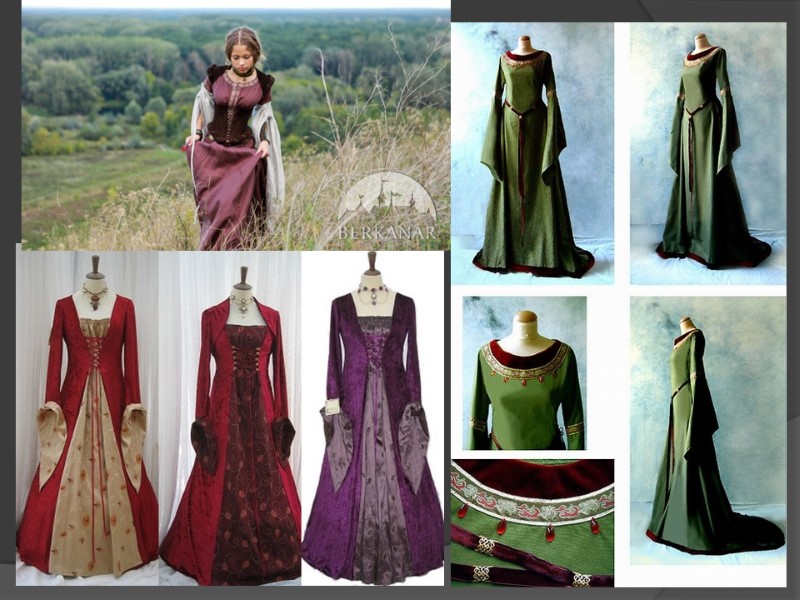
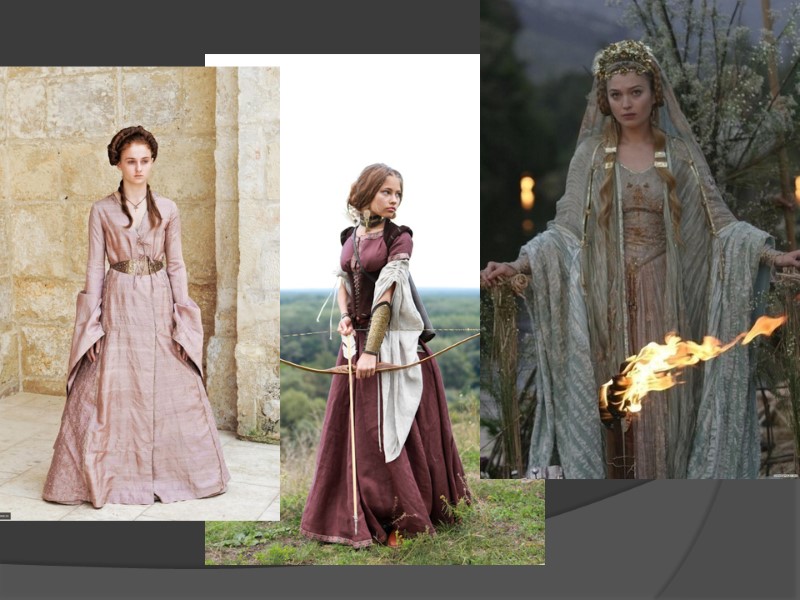
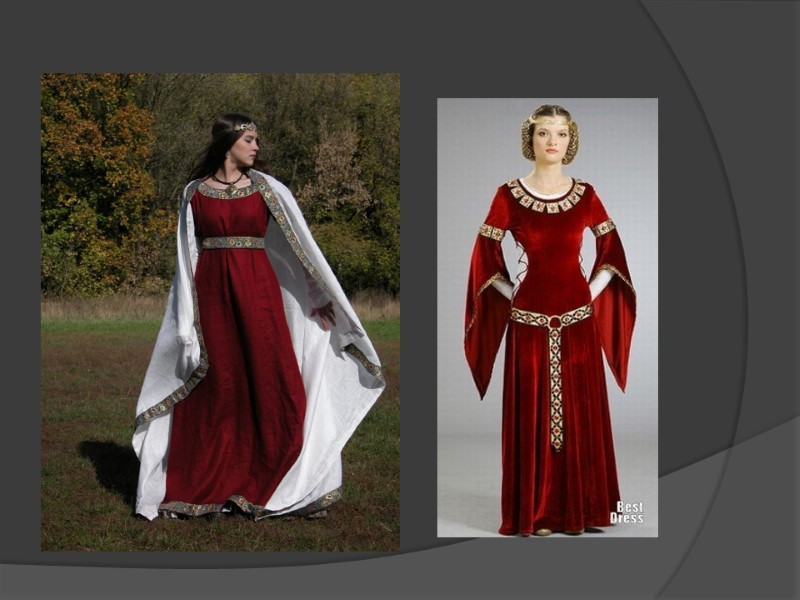
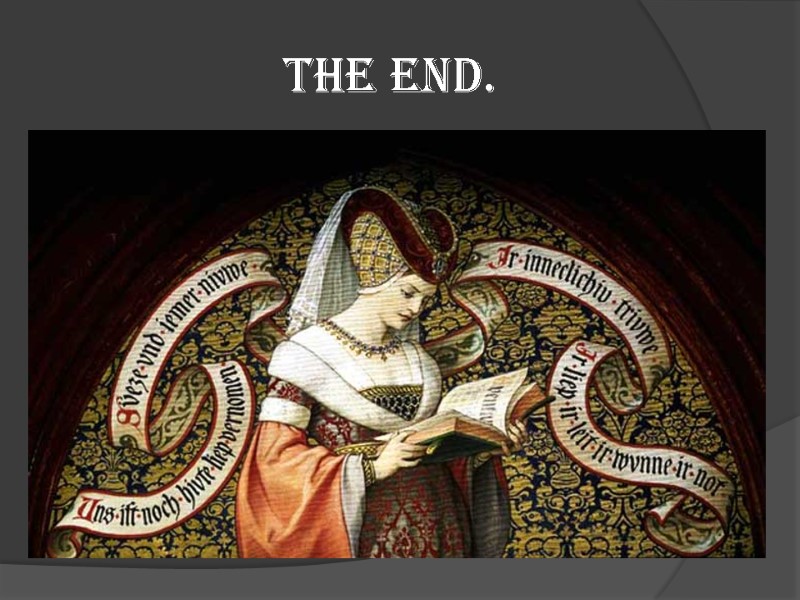
The end.
10814-the_costume_of_the_late_middle_ages.ppt
- Количество слайдов: 25

